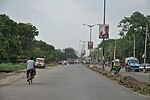The Barrackpore mutiny was a rising of native Indian sepoys against their British officers in Barrackpore in November 1824. The incident occurred when the British East India Company was fighting the First Anglo-Burmese War (1824–1826) under the leadership of the Governor-General of Bengal, William Amherst, 1st Earl Amherst.The mutiny had its roots in British insensitivity towards Indian cultural sentiments, combined with negligence and poor supply arrangements, which caused growing resentment amongst the sepoys of several regiments of the Bengal Native Infantry after a long march from Mathura to Barrackpore. The lack of transport for personal effects and cultural concerns about being transported by sea caused apprehension and when troops from the 47th Native Infantry appeared on parade, the troops refused to march towards Chittagong, unless their grievances were remedied. Attempts to resolve the dispute failed and dissent spread to elements of the 26th and 62nd Regiments. The Commander-in-Chief, India, General Sir Edward Paget, ordered the troops to lay down their arms before considering their requests for redress. When the sepoys refused, their camp was surrounded by loyal soldiers from the 26th and 62nd Regiments and two British regiments. After a final ultimatum, the camp was attacked with artillery and infantry and around 180 sepoys were killed, as were a number of civilian bystanders.
In the aftermath, a number of mutineers were hanged and others sentenced to long periods of penal servitude. The 47th Regiment was disbanded and its Indian officers dismissed, while its European officers were transferred to other regiments. The incident was largely suppressed in the Indian and British media, with only limited information being released to the British public; despite this, there was Parliamentary criticism of the East India Company government for its heavy-handedness in dealing with the sepoys' grievances.










